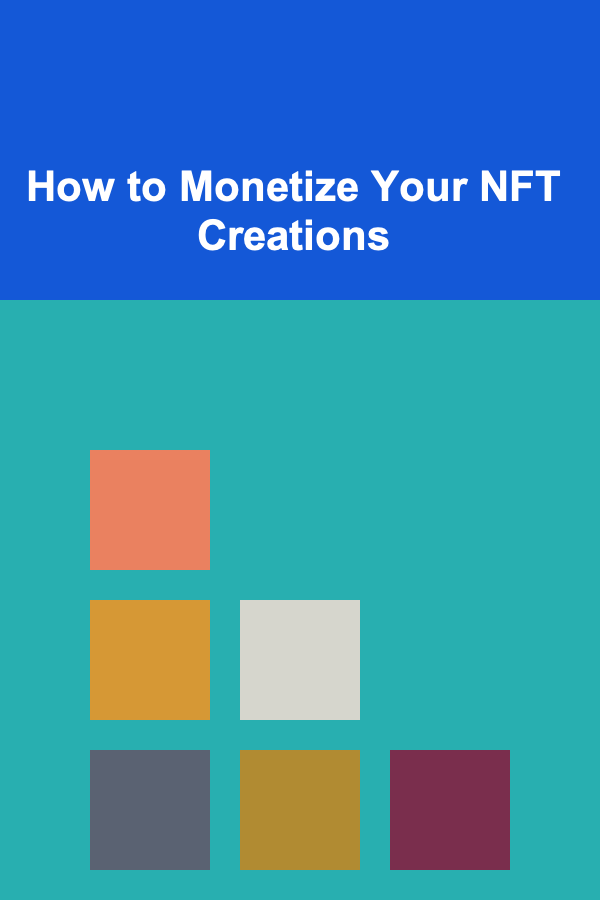
How to Monetize Your NFT Creations
ebook include PDF & Audio bundle (Micro Guide)
$12.99$7.99
Limited Time Offer! Order within the next:

The world of Non-Fungible Tokens (NFTs) has rapidly emerged as a revolutionary space, offering new opportunities for digital creators, artists, and entrepreneurs to monetize their work. NFTs provide a unique way to sell digital art, music, videos, and other forms of creative content. However, understanding how to effectively monetize your NFT creations can be challenging. In this article, we will explore various strategies, techniques, and platforms to help you monetize your NFT creations, turning your passion into profit.
What Are NFTs?
Before delving into monetization strategies, it's important to understand what NFTs are. NFTs are digital assets that represent ownership or proof of authenticity of a specific item or piece of content, stored on the blockchain. Unlike cryptocurrencies like Bitcoin or Ethereum, which are fungible (interchangeable with each other), NFTs are unique and cannot be exchanged on a one-to-one basis.
NFTs are often used for art, music, videos, and other forms of digital media. The value of an NFT is driven by its rarity, the fame of the creator, and the demand for the digital item. These factors, combined with blockchain technology's ability to prove ownership, make NFTs an exciting and valuable space for creators and collectors alike.
Different Ways to Monetize NFTs
Now that we understand NFTs, let's explore how to monetize them effectively. Monetization can happen in several ways, depending on your creation and approach. Here are some of the most common methods:
a. Selling Your NFT Artworks
The most straightforward way to monetize your NFTs is to sell them. Artists and creators can mint (create) their digital artwork as an NFT and list it for sale on NFT marketplaces. The price of an NFT artwork is determined by factors such as the artist's reputation, the uniqueness of the work, the demand from buyers, and the rarity of the NFT.
Steps to sell NFT art:
- Create Your Artwork: The first step is to create the digital content you want to sell. This could be anything from a digital painting, an animated GIF, a 3D model, or a music track.
- Choose a Blockchain: Most NFTs are minted on the Ethereum blockchain, but other blockchains such as Binance Smart Chain, Solana, and Flow also support NFTs. Each blockchain has its pros and cons in terms of transaction fees, speed, and accessibility.
- Mint Your NFT: Once your artwork is ready, you need to mint it as an NFT. This process involves uploading your digital file to a platform that allows you to create NFTs. The minting process involves a fee, called a "gas fee," which can vary depending on the blockchain and the marketplace.
- List Your NFT for Sale: Once minted, you can list your NFT for sale on NFT marketplaces like OpenSea, Rarible, Foundation, or SuperRare. You can set a fixed price or opt for an auction-style listing, where buyers bid for your work.
- Promote Your NFT: As with any form of art or product, promotion is key. Use social media platforms like Twitter, Instagram, and Discord to build a community around your work. Engage with followers, share your creative process, and provide regular updates to keep interest high.
Key Points to Remember:
- Choose a blockchain and marketplace that aligns with your needs.
- Ensure your artwork is unique, authentic, and high-quality.
- Actively engage with the NFT community to build a loyal following.
b. Royalties from Resale
One of the most appealing aspects of NFTs for creators is the ability to earn royalties on secondary sales. When an NFT is resold on the marketplace, the original creator can receive a percentage of the sale price. This is an automatic feature in many NFT platforms and smart contracts.
For example, if you sell an NFT for $1,000 and the buyer later resells it for $5,000, you could earn a royalty (typically around 5-10%) from that secondary sale. This means you can continue earning from your work long after the initial sale.
How royalties work:
- Smart Contracts: NFTs are built on smart contracts that automatically enforce the terms of the sale, including the royalty percentage for the creator. Once your NFT is minted and sold, the smart contract is responsible for transferring ownership while ensuring that royalties are sent to you whenever the NFT is resold.
- Royalties on Multiple Platforms: Different NFT platforms allow for varying royalty percentages. Ensure that the platform you use supports automatic royalties on secondary sales.
Key Points to Remember:
- Choose platforms that support royalties on secondary sales.
- Understand the royalty structure and set a percentage that works for you.
- Promote your work to encourage future resales.
c. Collaborations and Partnerships
Another effective way to monetize your NFT creations is through collaborations with other artists, brands, or influencers. Collaborations can provide exposure to new audiences, allow you to combine creative forces, and enhance the overall value of the NFT.
For instance, a digital artist could collaborate with a musician to create a multimedia NFT, combining visual art with a music track. Similarly, influencers or brands may want to partner with creators to release limited edition NFTs for their audience.
Steps for successful collaboration:
- Identify Potential Partners: Look for artists or brands whose style or audience aligns with yours. Potential partners could be other NFT creators, musicians, fashion designers, or companies in the metaverse.
- Discuss the Terms: Clearly define the terms of your collaboration, including how royalties will be split, who will promote the NFTs, and how the work will be marketed.
- Launch the Collaboration: Once the project is finalized, launch it on an NFT marketplace and promote it across your networks. Collaborations often generate more attention, leading to higher sales and more opportunities in the future.
Key Points to Remember:
- Collaborate with creators and brands that complement your style and audience.
- Ensure that terms of the collaboration are clear and fair.
- Use collaborations as a way to cross-promote and reach new markets.
d. NFT Gated Content and Memberships
NFTs can also be used as a key to unlock exclusive content or membership benefits. For example, you could create an NFT that grants access to a private community, special content, or even future NFT drops. This approach allows you to generate revenue from exclusive content while fostering a sense of community among your supporters.
How to implement gated content:
- Create Exclusive Content: Design a specific piece of content or experience that is only available to NFT holders. This could be a private art gallery, a live event, exclusive music, or limited-edition merchandise.
- Set Up Access Control: Use NFT platforms that offer gating features. This ensures that only the holders of specific NFTs can access your exclusive content.
- Market the Membership: Promote the NFT as part of an exclusive community or offer perks that attract collectors who want to be part of the inner circle. The value lies in the scarcity and exclusivity of the content.
Key Points to Remember:
- Offer valuable and exclusive content to NFT holders.
- Use gated access to create a sense of belonging for collectors.
- Continuously deliver value to retain members and keep them engaged.
e. NFT Merchandise
NFTs can also be used to create limited-edition merchandise. By linking physical items with NFTs, creators can sell both digital and tangible products. For example, a digital artist might offer a physical print of their artwork along with the NFT, or a musician might sell exclusive concert tickets along with an NFT album.
The advantage of offering NFT-linked merchandise is that it gives physical products a digital layer of authenticity and traceability. Collectors can prove they own a limited edition of an item, which adds to its appeal and exclusivity.
Steps to create NFT merchandise:
- Design Physical Products: Decide what physical products you want to sell alongside your NFTs. This could range from clothing, prints, and posters to concert tickets, vinyl records, or collectibles.
- Link the Physical Product to an NFT: Use NFT platforms that allow you to associate a physical item with an NFT. The NFT acts as a certificate of authenticity, guaranteeing the ownership and uniqueness of the product.
- Offer Limited Editions: Exclusivity is key in the NFT space. Offering limited-edition merchandise linked to NFTs enhances the perceived value of your products.
Key Points to Remember:
- Create unique physical products linked to NFTs.
- Offer limited editions to increase demand and exclusivity.
- Ensure authenticity and traceability through NFTs.
f. NFTs for Fundraising and Crowdfunding
NFTs can also be used as a way to fundraise or crowdfund projects. Creators can sell NFTs to raise money for new projects, whether it's for creating more artwork, funding a music album, or launching a new brand. This method has become particularly popular among musicians and independent artists who want to retain full control over their work while raising capital from their fanbase.
How to use NFTs for fundraising:
- Create an NFT Collection: Design a series of NFTs related to your upcoming project. These NFTs can represent different levels of support or exclusive access to content.
- Launch a Crowdfunding Campaign: Use NFT marketplaces to sell your NFTs as part of a crowdfunding campaign. Be transparent about your goals and how the funds will be used.
- Offer Backer Rewards: Provide special rewards for NFT holders, such as early access to content, credits in a project, or VIP experiences.
Key Points to Remember:
- Be clear about the purpose of your fundraising and how the money will be used.
- Offer rewards that add value to your backers and create a sense of involvement in your project.
- Promote your crowdfunding campaign to attract supporters.
Final Thoughts
The NFT space is rapidly evolving, and there are endless possibilities for creators to monetize their digital works. Whether you're an artist, musician, or content creator, NFTs offer a unique way to sell your creations, earn royalties, and connect with your audience. The key to success lies in understanding the different monetization methods, choosing the right platform, and engaging with your community. By combining creativity with smart strategies, you can turn your NFT creations into a sustainable and profitable venture.
Reading More From Our Other Websites
- [Home Rental Property 101] How to Create a Comprehensive Rental Agreement
- [Personal Investment 101] How to Profit from AI Automation Using Deep Learning
- [Organization Tip 101] How to Use a Bulletin Board for Laundry Reminders
- [Organization Tip 101] How to Maintain Your Floor After Installing Self-Leveling Underlayment
- [Home Budget Decorating 101] How to Mix and Match Affordable Furniture Pieces for a Unique Look
- [Home Lighting 101] How to Hang Pendant Lighting for a Charming Home Atmosphere
- [Home Party Planning 101] How to Organize a Party Playlist That Keeps Everyone Dancing
- [Home Lighting 101] How to Choose Lighting for Your Home's Open Concept Floor Plan
- [Scrapbooking Tip 101] DIY Textured Cardstock Techniques: Elevate Your Scrapbook Pages
- [Personal Investment 101] How to Review and Rebalance Your Investment Portfolio

How to Break Into Competitive Fields: Strategies for Success
Read More
How to Mix Vintage and Modern Items for Unique Decor
Read More
How to Use Clever Storage Ideas to Maximize Your Apartment Space
Read More
How to Upcycle Old Clothes and Furniture
Read More
How To Deal with Sudden Weather Changes on the Trail
Read More
How To Create a Job Search Action Plan
Read MoreOther Products

How to Break Into Competitive Fields: Strategies for Success
Read More
How to Mix Vintage and Modern Items for Unique Decor
Read More
How to Use Clever Storage Ideas to Maximize Your Apartment Space
Read More
How to Upcycle Old Clothes and Furniture
Read More
How To Deal with Sudden Weather Changes on the Trail
Read More